Natural Solutions to Things That Bug You (50 page)
Read Natural Solutions to Things That Bug You Online
Authors: Myles Bader

IT’S A PITHY
Since the damage extends into the pith it is best to remove all the injured canes and burn them.
The more numerous the rows of holes are the more likely that the canes will just fall over. Burning is the best method of eliminating the eggs. The chemical derris is also used successfully on these bugs.
WEEVILS
Identification:
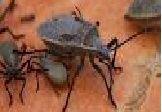 This long snout beetle loves grains. They have a strong pair of mandibles at the end of their snout that is capable of opening most seeds, which they then lay their eggs in. The eggs hatch into larvae; that will eat the inside of the seed and allows the shell to remain intact.
This long snout beetle loves grains. They have a strong pair of mandibles at the end of their snout that is capable of opening most seeds, which they then lay their eggs in. The eggs hatch into larvae; that will eat the inside of the seed and allows the shell to remain intact.
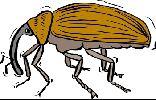
General Information:
Weevils are one of the hardest beetles to control. They may also attack fruit trees, cotton, rhubarb and a variety of vegetables. The bean weevil loves beans and peas; however, if none are available they will eat almost any other vegetables.
WORM THEM OUT
Best to eliminate them with Nc nematodes, which has been found to be one of the most efficient methods of controlling weevils.
GLUE THEM UP
Weevils normally crawl to your houseplants, especially vine weevils. However, the weevils can be stopped, by placing a thin bead of non-setting glue or Tanglefoot™ around the plants. This can get a bit messy but it does work well.
PEPPER THEM
 Black pepper can be placed into foods that you ordinarily place it in to keep the bugs out. Even some beetles that will consume red pepper will not eat black pepper in most instances. Black pepper will actually kill the pests. The USDA found that 500 parts per million of black pepper will kill 97% of the weevils in wheat.
Black pepper can be placed into foods that you ordinarily place it in to keep the bugs out. Even some beetles that will consume red pepper will not eat black pepper in most instances. Black pepper will actually kill the pests. The USDA found that 500 parts per million of black pepper will kill 97% of the weevils in wheat.
COWPEA CURCULIOS (BEAN WEEVIL)
These are small black or brown beetles that have a snout and have reddish legs and antennae.
They lay their eggs in holes that are chewed along the bean pod seams. The tiny white grub then feeds on the young seed and tends to come out when the beans are in storage and leave a small round hole when exiting.
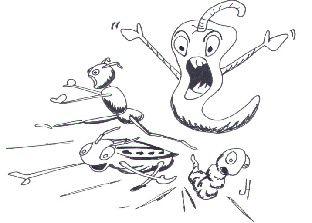 They prefer southern peas and love Lima beans. Praying mantis, love to dine on these bugs! Spray the pods with a soap and pepper spray and they won’t lay their eggs. Nc nematodes also will eliminate the problem. Stored dry beans; can be protected by heating them to 135
They prefer southern peas and love Lima beans. Praying mantis, love to dine on these bugs! Spray the pods with a soap and pepper spray and they won’t lay their eggs. Nc nematodes also will eliminate the problem. Stored dry beans; can be protected by heating them to 135
F for 3-4 hours or suspending the seeds in a bag of tap water and heating it to 140
F before drying them very rapidly.

SCARE THEM OFF
Weevils tend to take up residence in dried beans and most grains. However, if you place a dried hot chili pepper in with the beans or grains you will never find another weevil or other insect in your beans and grains.
Placing the beans in the foods will not affect the foods.
LEAF NOTCHER
General Information:
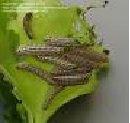 The black or brown vine weevil is a very shy bug that only feeds at night and will munch notches around the edges of the leaves of the yew tree, rhododendron bushes, azaleas and most other ornamental shrubs. It will lay its eggs in the soil, which hatch into white legless grubs, which will feed on the roots of your plants. They hide in mulch and leaf litter during the day. Place Tanglefoot™ around the trunk of bushes and trees to keep them off. Rake in Nc nematodes to be rid of them permanently.
The black or brown vine weevil is a very shy bug that only feeds at night and will munch notches around the edges of the leaves of the yew tree, rhododendron bushes, azaleas and most other ornamental shrubs. It will lay its eggs in the soil, which hatch into white legless grubs, which will feed on the roots of your plants. They hide in mulch and leaf litter during the day. Place Tanglefoot™ around the trunk of bushes and trees to keep them off. Rake in Nc nematodes to be rid of them permanently.
NUTTY WEEVILS
General Information:
These go by a number of nutty names such as the pecan weevil, chestnut weevil and the other nut weevil. All three are similar and have long snouts, which are actually as long as their bodies. The females use their snout to bite holes in developing nuts, which is where they lay their eggs.
The eggs hatch about the same time as when the nuts are ready to fall to the ground. If you spread Nc nematodes under the tree in the late summer when the nuts fall it will eliminate the problem.
STRAWBERRY ROOT WEEVILS ARE SHY
General Information:
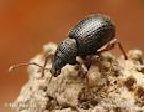 These weevils feed on the upper parts of the plants and then lay their eggs in the soil. Their grubs feed on the plant roots and heavy infestations will easily kill the plant. Mulch containing Nc nematodes and a somewhat sandy soil around the plants will solve the problem. You can hand pick them, however, the adults only come out at night and are very shy.
These weevils feed on the upper parts of the plants and then lay their eggs in the soil. Their grubs feed on the plant roots and heavy infestations will easily kill the plant. Mulch containing Nc nematodes and a somewhat sandy soil around the plants will solve the problem. You can hand pick them, however, the adults only come out at night and are very shy.

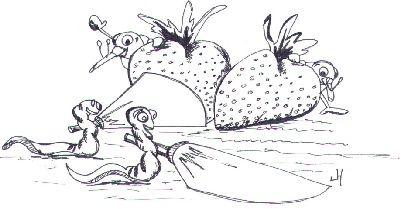
SWEET POTATO WEEVIL
General Information:
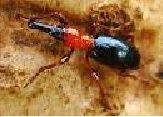 This beetle looks like an ant and has a snout and a black body. They mainly eat foliage and lay their eggs on the stem and tubers of plants. When the grubs hatch they will eat down the stem into any tuber or potato that is available. These are normally only found in the southern United States. It also likes to eat stored sweet potatoes. If you get an infestation it would be best to burn the crop, however, Nc nematodes do work as a good preventive measure.
This beetle looks like an ant and has a snout and a black body. They mainly eat foliage and lay their eggs on the stem and tubers of plants. When the grubs hatch they will eat down the stem into any tuber or potato that is available. These are normally only found in the southern United States. It also likes to eat stored sweet potatoes. If you get an infestation it would be best to burn the crop, however, Nc nematodes do work as a good preventive measure.